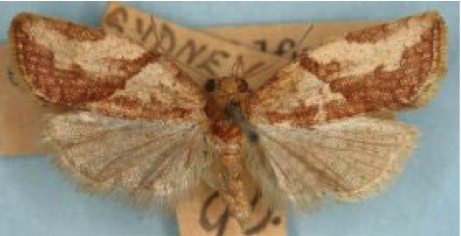PESTS AND DISEASES OF FORESTRY IN NEW ZEALAND
Light brown apple moth in California
Scion is the leading provider of forest-related knowledge in New Zealand
Formerly known as the Forest Research Institute, Scion has been a leader in research relating to forest health for over 50 years. The Rotorua-based Crown Research Institute continues to provide science that will protect all forests from damage caused by insect pests, pathogens and weeds. The information presented below arises from these research activities.
From Forest Health News 171, March 2007.

Epiphyas postvittana (light brown apple moth) is a south-east Australian leaf-rolling moth that was first found in New Zealand in 1887. It has also become established in Tasmania, south-western Australia, New Caledonia, Hawaii, and the United Kingdom.
Recently two E. postvittana moths were caught in a light trap near Berkeley, California. This prompted a response from the USDA Agriculture & Plant Inspection Service (APHIS) and the California Department of Food & Agriculture. Pheromone traps were deployed to determine the distribution of the moth, and vegetation was controlled to minimise the spread of the insect. Very soon after this detection in California, APHIS formed a Technical Working Group (TWG) to discuss and recommend survey methods, mitigation procedures, and eradication strategies.
Two New Zealanders, Ecki Brockerhoff (Ensis) and Max Suckling (HortResearch), are members of the TWG.
So far E. postvittana has been confirmed in eight counties, centred mainly around the San Francisco Bay area. If left uncontrolled E.postvittana would pose a very significant threat to California’s enormous fruit industry — hence the rapid response from both State and Federal authorities.
The first New Zealand record (1887) of E. postvittana was a specimen now in the Canterbury Museum, labelled “reared from Tasmanian apples”.
By the 1890s it was widespread here. In New Zealand it has been recorded from more than 265 hosts but is best known as a serious pest of horticultural fruit crops, pomefruit, and berry fruit. On occasion it can be a problem in young, coniferous forest plantations. In conifers, in addition to feeding on the needles, the larvae use the stems and apical
buds as winter feeding and refuge areas. The bud is destroyed and this can result in kinked, malformed stems and multiple leaders. Pseudotsuga menziesii and Larix species are more susceptible to this type of damage than Pinus spp. Chemical control of E. postvittana (and other tortricids) is common in nurseries.
For further information on the Californian situation see:
http://www.cdfa.ca.gov/phpps/PDEP/lbam/lbam-main.html
and
http://capitalpress.com/Main.asp?SectionID=94&ArticleID=31718
John Bain & Ecki Brockerhoff
This information is intended for general interest only. It is not intended to be a substitute for specific specialist advice on any matter and should not be relied on for that purpose. Scion will not be liable for any direct, indirect, incidental, special, consequential or exemplary damages, loss of profits, or any other intangible losses that result from using the information provided on this site.
(Scion is the trading name of the New Zealand Forest Research Institute Limited.)



